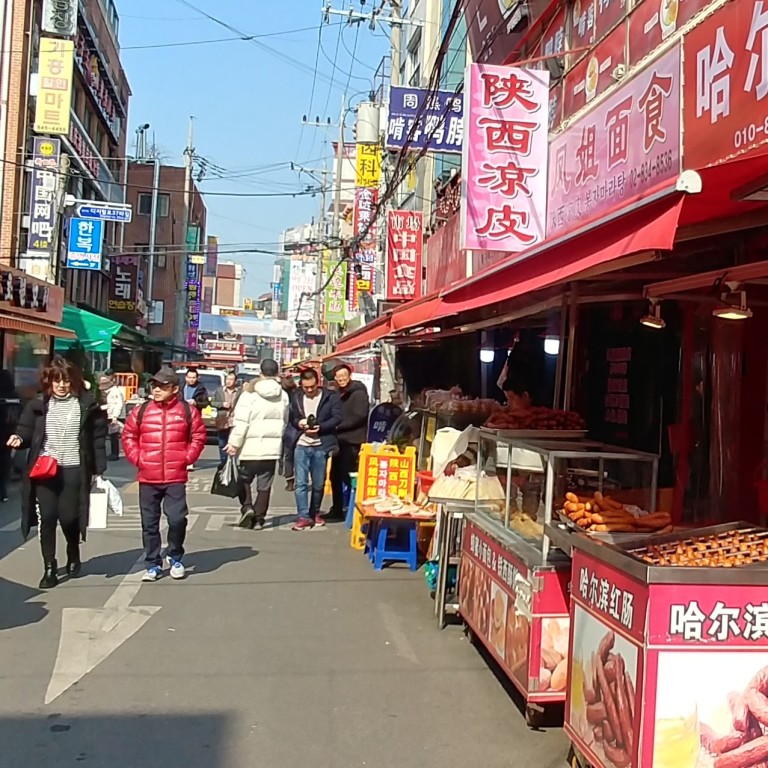
For Chinese immigrants, there is no place like home in Seoul’s Chinatown
- The district near Daelim Station has also become Korean foodies’ haunt
- But South Korea’s economic downturn taking a toll on businesses there
Take Seoul’s subway No 2 or No 7 and get off at Daelim Station. Emerge from Exit 12 and you would feel as if you had just entered a different world. Welcome to Chinatown, a favourite haunt of Chinese immigrants in the South Korean capital.
On a Wednesday afternoon, Lee Geum-yong, 40, and his wife were tucking into rice porridge, dumplings and pancakes at a modest restaurant.
“Whenever we miss Chinese food, we come to this district,” said Lee, who is of Korean ancestry and moved to Seoul in 1999.
“Prices are good and food is exactly like what we used to eat at our hometown in Harbin,” he said, referring to the northeastern province of Heilongjiang in China. “Here, it seems like an ordinary Chinese town was moved as a whole to this place”.
Seoul’s Chinatown bears similarities to others around the world. Signboards are in Chinese and shopkeepers are more comfortable using the language rather than speaking haltingly in Korean.
Narrow streets are lined with low-rise buildings with storefront shops selling ingredients for Chinese cuisine, stalls piled up with dumplings, sausages, pancakes and even dog meat, and restaurants specialising in simmering hotpot, noodles and various other dishes.

On weekdays, most of the visitors are immigrants of Korean ancestry from northeastern China, who can obtain visas to stay and work permanently in South Korea. On weekends, it has become an increasingly favoured haunt of local foodies.
“You can buy Chinese food which is hard to find elsewhere in the country,” said a 64-year-old construction worker from Changchun in Jilin province, before he scurried away with a plastic bag containing Korean-style sausages.
Lee Dong-wook, who heads an informal grouping of business owners of Chinese ancestry in the district, said Chinatown grew spontaneously as immigrants were attracted by its proximity from the city centre and low rental. It soon became the first port of call for new arrivals, as they could meet recruiters and learn skills to work at construction sites, become cooks, bakers, and hairdressers.
How South Korea’s 2010 ban on cross-border trade burned one man’s dream of building a fried chicken empire in the North
About 90 Chinese immigrants lived there in 2003, and the number has grown to more than 9,000 as of last year. In the same period, the population of ethnic South Koreans halved to 14,000.
But the district also became widely known among South Koreans after a 2017 Korean action-comedy movie Midnight Runners depicted the district as being overrun by criminals, sparking angry protests from residents there.
“South Koreans have come to know the reality is different and since then, they have started coming to this area in growing numbers to eat Chinese food,” Lee Dong-wook said.
The 46-year-old Lee has a rags-to-riches story. He arrived in South Korea in 2001 with his wife, on a two-year visa tied to his apprentice job at a factory manufacturing aluminium window panes in the southern province of Jeolla. But after several months of receiving 500,000 won (US$446) as his monthly salary, only one-fourth of what he had been promised, he left the plant and breached his visa conditions, turning him into an illegal immigrant.
South Korea scraps disposable plastic bags after waste crisis brought on by China import ban
Since then, he had worked as a servant in restaurants and was a small-time merchant before finally settled into a job at a funeral house, where he worked for three years before setting up his own funeral parlour in 2009.
“Diligence and honesty will eventually pay off,” he said in his office located deep inside his shop, which doubles up as a funeral service house and a money exchange outlet. A framed slogan “honesty, sincerity and passion” hung on the wall behind him.
Hong Se-hwa, 35, also a Chinese of Korean ancestry who operates a thriving noodle shop at the district’s Jungang open market, said Seoul’s Chinatown is distinctive in that it makes Chinese visitors “feel at home”.

Restaurants stick to their “unmitigated” recipes from China, signboards and menus are all Chinese style and many merchants speak Chinese better than Korean, while other Chinatowns in the country largely pander to South Koreans, serving “Koreanised” Chinese food, she said.
Hong came to South Korea alone in 2008, worked at restaurants and operated a pushcart in an open market before she opened a noodle and dumpling restaurant at the Joongang open market in Daelim 2 district.
Her Lingongzi knife-sliced noodle restaurant has become so popular among South Koreans that a local television programme recently picked it as one of must-eat restaurants for gourmets.
But South Korea’s economic slowdown – growth was at 2.7 per cent in 2018, down from 3.1 per cent the previous year – has dampened business, the shop owners say.
A middle-aged woman from Jilin province, who operates a restaurant and a shop selling sausages, condiments, chicken and dog meat, said sales fell 30 per cent over the past year even as the price or raw ingredients rose.
Hanoi puts its best food forward for Trump-Kim summit
To make matters worse for her, she has to pay higher wages for the five employees working at her restaurant after the liberal government of President Moon Jae-in increased the country’s minimum wage by 16.4 per cent last year.
Two years ago, Hong invested 600 million won she had borrowed from her relatives in China for her business, and she now struggles to pay them the interest on the loans.
Kim Yoon-ock, 58, also said the number of Chinese immigrants visiting her restaurant had fallen over the past year because of the growing economic slowdown.
“Many Chinese workers are now unable to find jobs and they don’t have money to spend. Therefore, they stopped coming out to eat in the streets,” said Kim who left her hometown near Shenyang in 1995 to work at a restaurant in South Korea.
“Instead, South Koreans come here in increasing numbers these days,” said Kim, who has been running the restaurant for the past decade.
China’s Dilmurat to Japan’s Rola, why do Asians feishise mixed race celebrities?
Lee Geum-yong, who was eating with his wife at Kim’s restaurant, said he himself was unable to find work. “Normally, I work at a construction site at this hour. But it’s not easy to find jobs these days.”
Lee Dong-wook, the funeral house operator, said despite the breakdown in talks during the highly anticipated second summit between US President Donald Trump and North Korean leader Kim Jong-un in Hanoi, he is still pinning his hopes on the ongoing diplomatic rapprochement between the two Koreas.
“Kim Jong-un is different from his late father and grandfather as he is in favour of Vietnam-style market-oriented reforms. If things go well, it would open a new path for an economic breakthrough for both Koreas,” he said.
If sanctions against the North are lifted and the two Koreas freely engage in cross-border economic cooperation and exchanges, the benefits would amount to some 380 trillion won (US$340 billion) over the next 20 years, the South’s IBK Economic Research Institute said in a report this month.

